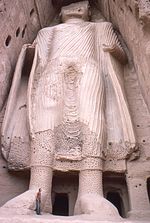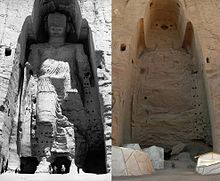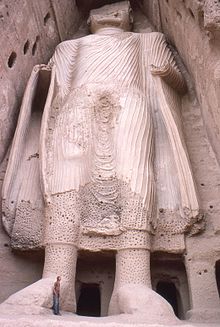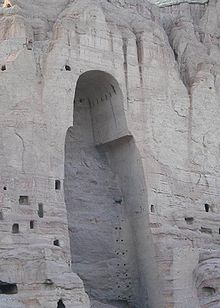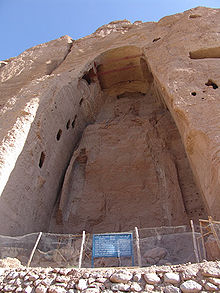- Buddhas of Bamiyan
-
Coordinates: 34°49′55.35″N 67°49′36.49″E / 34.8320417°N 67.8268028°E
Cultural Landscape and Archaeological Remains of the Bamiyan Valley * UNESCO World Heritage Site
The taller of the two Buddhas of Bamiyan in 1976Country Afghanistan Type Cultural Criteria i, ii, iii, iv, vi. Reference 208 Region ** Asia-Pacific Inscription history Inscription 2003 (Twenty seventh Session) Endangered 2003- * Name as inscribed on World Heritage List
** Region as classified by UNESCOHistory of Afghanistan Timeline Bronze age and Proto-Elamite culture in Nimruz area (2300–1800 BC) Bronze age and Indus valley civilization in Mundigak (Kandahar area) (2200–1800 BC) Bronze age and Oxus civilization in northern Afghanistan (2100–1800 BC) Late Bronze age and Iron age and coming of Aryans (1700–700 BC) Median Empire (728–550 BC) Achaemenids (550–330 BC) Seleucids (330–150 BC) Mauryans (305–180 BC) Greco-Bactrians (256–125 BC) Indo-Greeks (180–130 BC) Indo-Scythians (Sakas) (155–80? BC) Indo-Parthians (20 BC–50? AD) Kushans (135 BC–248 AD) Sassanids (230–565) Indo-Sassanids (248–410) Kidarites (320–465) Hephthalites (410–557) Kabul Shahi (565–879) Rashidun Caliphate (642–641) Umayyads (661–750) Abbasids (750–821) Tahirids (821–873) Saffarids (863–900)) Samanids (875–999) Ghaznavids (963–1187) Seljukids (1037–1194) Khwarezmids (1077–1231) Ghorids (1149–1212) Ilkhanate (1258–1353) Kartids (1245–1381) Timurids (1370–1506) Arghun (1479-1522) Mughals (1501–1738) Safavids (1510–1709) Hotaki dynasty (1709–1738) Afsharids (1738–1747) Durrani Empire (1747–1826) Emirate of Afghanistan (1826–1919) Kingdom of Afghanistan (1919–1973) Republic of Afghanistan (1973–1978) Democratic Republic (1978–1992) Islamic State (1992–1996) Islamic Emirate (1996–2001) Islamic Republic (2001–) Afghan Civil War 1979–1989 1989–1992 1992–1996 1996–2001 2001–present
The Buddhas of Bamiyan (Persian: بت های باميان – but hay-e bamiyan) were two 6th century[1] monumental statues of standing buddhas carved into the side of a cliff in the Bamyan valley in the Hazarajat region of central Afghanistan, situated 230 km (140 mi) northwest of Kabul at an altitude of 2,500 meters (8,202 ft). Built in 507 CE, the larger in 554 CE,[1] the statues represented the classic blended style of Gandhara art.[2]
The main bodies were hewn directly from the sandstone cliffs, but details were modeled in mud mixed with straw, coated with stucco. This coating, practically all of which was worn away long ago, was painted to enhance the expressions of the faces, hands and folds of the robes; the larger one was painted carmine red and the smaller one was painted multiple colors.[3]
The lower parts of the statues' arms were constructed from the same mud-straw mix while supported on wooden armatures. It is believed that the upper parts of their faces were made from great wooden masks or casts. The rows of holes that can be seen in photographs were spaces that held wooden pegs which served to stabilize the outer stucco.
They were dynamited and destroyed in March 2001 by the Taliban, on orders from leader Mullah Mohammed Omar,[4] after the Taliban government declared that they were "idols".[5] International opinion strongly condemned the destruction of the Buddhas, which was viewed as an example of the intolerance of the Taliban. Japan and Switzerland, among others, have pledged support for the rebuilding of the statues.[6]
Contents
History
Bamiyan lies on the Silk Road which lies in the Hindu Kush mountain region, in the Bamiyan Valley. The Silk Road is a caravan route linking the markets of China with those of Western Asia. Until the 11th century, Bamiyan was part of the kingdom of Gandhara. It was the site of several Buddhist monasteries, and a thriving center for religion, philosophy, and Indian art. It was a Buddhist religious site from the 2nd century up to the time of the Islamic invasion in the 9th century. Monks at the monasteries lived as hermits in small caves carved into the side of the Bamiyan cliffs. Many of these monks embellished their caves with religious statuary and elaborate, brightly colored frescoes.
The two most prominent statues were the giant standing Buddhas Vairocana and Sakyamuni, identified by the different mudras performed, measuring 55 and 37 metres (180 and 121 feet) high respectively. Before being blown up in 2001 they were the largest examples of standing Buddha carvings in the world. Since then the Spring Temple Buddha has been built in China, and at 128 m (420 ft) it is the tallest statue in the world. Plans for the construction of the Spring Temple Buddha were announced soon after the blowing up of the Bamiyan Buddhas and China condemned the systematic destruction of the Buddhist heritage of Afghanistan.
The smaller of the statues was built between 544 and 595, the larger was built between 591 and 644.[7] They are believed to have been built by the Kushans, with the guidance of local Buddhist monks, at the heyday of their empire. The larger figure was also said to portray Dīpankara Buddha. They were perhaps the most famous cultural landmarks of the region, and the site was listed by UNESCO as a World Heritage Site along with the surrounding cultural landscape and archaeological remains of the Bamiyan Valley.
The Chinese Buddhist pilgrim Xuanzang passed through the area around 630,[8][9] and described Bamiyan in the Da Tang Xiyu Ji as a flourishing Buddhist center "with more than ten monasteries and more than a thousand monks". He also noted that both Buddha figures were "decorated with gold and fine jewels" (Wriggins, 1995). Intriguingly, Xuanzang mentions a third, even larger, reclining statue of the Buddha.[3][9][10] A monumental seated Buddha, similar in style to those at Bamiyan, still exists in the Bingling Temple caves in China's Gansu province.
The destruction of the Bamyan Buddhas became a symbol of oppression and a rallying point for the freedom of religious expression. Despite the fact that most Afghans are now Muslim, they too had embraced their past and many were appalled by the destruction.[11][12][13]
Attacks on the Buddha's statue
11th to the 20th century
The enormous statues, the male Salsal ("light shines through the universe") and the (smaller) female Shamama ("Queen Mother"),[14] as they were called by the locals, did not fail to fire the imagination of Islamic writers in centuries past. The larger statue reappears as the malevolent giant Salsal in medieval Turkish tales.[15]
Preface to 2001, under the Taliban
Abdul Wahed, a Taliban commander operating in the area, announced his intention to blow up the Buddhas in 1997 even before he had taken control of the valley. Once he was in control of Bamiyan in 1998, Wahed drilled holes in the Buddhas' heads for explosives. He was prevented from taking further action by the local governor and direct order of Mullah Omar, although tyres were burnt of the head on the great Buddha.[16] In July 1999, Mullah Mohammed Omar issued a decree in favor of the preservation of the Bamiyan Buddha's statue. Because Afghanistan's Buddhist population no longer exists, which removed the possibility of the statues being worshiped, he added: "The government considers the Bamiyan statues as an example of a potential major source of income for Afghanistan from international visitors. The Taliban states that Bamiyan shall not be destroyed but protected."[17] In early 2000, local Taliban authorities asked for UN assistance to rebuild drainage ditches around tops of the alcoves in which the Buddhas were set.[18]
However, Afghanistan's radical clerics began a campaign to crack down on "un-Islamic" segments of Afghan society. The Taliban soon banned all forms of imagery, music and sports, including television, in accordance with what they considered a strict interpretation of Sharia.[19]
Information and Culture Minister Qadratullah Jamal told Associated Press of a decision by 400 religious clerics from across Afghanistan declaring the Buddhist statues against the tenets of Islam. "They came out with a consensus that the statues were against Islam," said Jamal.
According to UNESCO Director-General Koïchiro Matsuura, a meeting of ambassadors from the 54 member states of the Organisation of the Islamic Conference (OIC) was conducted. All OIC states – including Pakistan, Saudi Arabia and the United Arab Emirates, three countries that officially recognised the Taliban government – joined the protest to spare the monuments.[20] Saudi Arabia and the United Arab Emirates later condemned the destruction as "savage".[21] Although India never recognised the Taliban regime in Afghanistan, New Delhi offered to arrange for the transfer of all the artifacts in question to India, "where they would be kept safely and preserved for all mankind.", but these overtures were rejected by the Taliban. Pakistani president Pervez Musharraf sent Moinuddin Haider to Kabul to try to prevent the destruction, by arguing that it was un-Islamic and unprecedented.[22] According to Taliban minister, Abdul Salam Zaeef, UNESCO sent the Taliban government 36 letters objecting to the proposed destruction. He asserted that the Chinese, Japanese and Sri Lankan delegates were the most strident advocates for preserving the Buddhas. The Japanese in particular proposed a variety of different solutions to the issue, these included removing the statues to Japan, covering the statues from view and the payment of money.[23]
A statement issued by the ministry of religious affairs of Taliban regime justified the destruction as being in accordance with Islamic law.[24] Abdul Salam Zaeef held that the destruction of the Buddhas was finally ordered by Abdul Wali, the Minister for the Propagation of Virtue and the Prevention of Vice.[25]
Dynamiting and destruction, March 2001
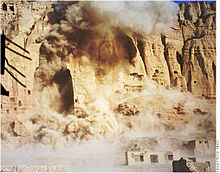 Destruction of the site by the Taliban
Destruction of the site by the Taliban
The statues were destroyed by dynamite over several weeks, starting on March 2, 2001,[26] carried out in different stages. Initially, the statues were fired at for several days using anti-aircraft guns and artillery. This caused severe damage, but did not obliterate them. During the destruction, Taliban Information Minister Qudratullah Jamal lamented that, "this work of destruction is not as simple as people might think. You can't knock down the statues by shelling as both are carved into a cliff; they are firmly attached to the mountain."[27] Later, the Taliban placed anti-tank mines at the bottom of the niches, so that when fragments of rock broke off from artillery fire, the statues would receive additional destruction from particles that set off the mines. In the end, the Taliban lowered men down the cliff face and placed explosives into holes in the Buddhas.[28] After one of the explosions failed to completely obliterate the face of one of the Buddhas, a rocket was launched which left a hole in the remains of the stone head.[29]
On 6 March 2001 The Times quoted Mullah Mohammed Omar as stating, "Muslims should be proud of smashing idols. It has given praise to God that we have destroyed them."[30] During a 13 March interview for Japan's Mainichi Shimbun, Afghan Foreign Minister Wakil Ahmad Mutawakel stated that the destruction was anything but a retaliation against the international community for economic sanctions: "We are destroying the statues in accordance with Islamic law and it is purely a religious issue".
On 18 March, The New York Times reported that a Taliban envoy said the Islamic government made its decision in a rage after a foreign delegation offered money to preserve the ancient works. The report also added, however, that other reports "have said the religious leaders were debating the move for months, and ultimately decided that the statues were idolatrous and should be obliterated."[31]
Then Taliban ambassador-at-large, Sayed Rahmatullah Hashemi, said that the destruction of the statues was carried out by the Head Council of Scholars after a single Swedish monuments expert proposed to restore the statues' heads. Hashimi is reported as saying: "When the Afghan head council asked them to provide the money to feed the children instead of fixing the statues, they refused and said, 'No, the money is just for the statues, not for the children'. Herein, they made the decision to destroy the statues"; however, he did not comment on the claim that a foreign museum offered to "buy the Buddhist statues, the money from which could have been used to feed children."[32]
Commitment to rebuild
Though the figures of the two large Buddhas are almost completely destroyed, their outlines and some features are still recognizable within the recesses. It is also still possible for visitors to explore the monks' caves and the passages which connect them. As part of the international effort to rebuild Afghanistan after the Taliban war, the Government of Japan and several other organizations, among them the Afghanistan Institute in Bubendorf, Switzerland, along with the ETH in Zurich, have committed to rebuilding, perhaps by anastylosis, the two largest Buddhas.
Developments since 2002
In May 2002, a mountainside sculpture of the Buddha was carved out of a mountain in Sri Lanka. It was designed to closely resemble one of the Buddhas of Bamiyan.
The Afghan government has commissioned Japanese artist Hiro Yamagata to recreate the Bamiyan Buddhas using fourteen laser systems to project the images of the Buddhas onto the cliff where they once stood. The laser systems will be solar and wind-powered. The project, which will cost an estimated $9 million, is currently pending UNESCO approval. If approved, the project is estimated to be completed by June 2012.
In September 2005, Mawlawi Mohammed Islam Mohammadi, Taliban governor of Bamiyan province at the time of the destruction and widely seen as responsible for its occurrence, was elected to the Afghan Parliament. On 26 January 2007, he was assassinated in Kabul.
Swiss filmmaker Christian Frei made a 95-minute documentary titled The Giant Buddhas (released in March 2006) on the statues, the international reactions to their destruction, and an overview of the controversy. Testimonies by local Afghans are recorded which validate that the destruction was ordered by Osama Bin Laden and that initially, Mullah Omar and the Afghans in Bamiyan had opposed the destruction.[33]
Since 2002, international funding has supported recovery and stabilization efforts at the site. Fragments of the statues are documented and stored with special attention given to securing the structure of the statue still in place. It is hoped that, in the future, partial anastylosis can be conducted with the remaining fragments. In 2009, ICOMOS constructed scaffolding within the niche to further conservation and stabilization. Nonetheless, several serious conservation and safety issues exist and the Buddhas are still listed as World Heritage in Danger.[34]
In the summer of 2006, Afghan officials were deciding on the timetable for the re-construction of the statues. As they wait for the Afghan government and international community to decide when to rebuild them, a $1.3 million UNESCO-funded project is sorting out the chunks of clay and plaster — ranging from boulders weighing several tons to fragments the size of tennis balls — and sheltering them from the elements.
The Buddhist remnants at Bamiyan were included on the 2008 World Monuments Watch List of the 100 Most Endangered Sites by the World Monuments Fund.
Oil painting discovery
After the destruction of the Buddhas, 50 caves were revealed. In 12 of the caves wall paintings were discovered.[35] In December 2004, an international team of researchers stated the wall paintings at Bamiyan were painted between the 5th and the 9th centuries, rather than the 6th to 8th centuries, citing their analysis of radioactive isotopes contained in straw fibers found beneath the paintings. It is believed that the paintings were done by artists travelling on the Silk Road, the trade route between China and the West.[36]
Scientists from the National Research Institute for Cultural Properties in Tokyo (Japan), the Centre of Research and Restoration of the French Museums-CNRS (France), the Getty Conservation Institute (United States) and the ESRF (the European Synchrotron radiation facility) in Grenoble analysed samples from the paintings,[37] typically less than 1 mm across.[38] They discovered that the paint contained pigments such as vermilion (red mercury sulfide) and lead white (lead carbonate). These were mixed with a range of binders, including natural resins, gums (possibly animal skin glue or egg)[38] and oils, probably derived from walnuts or poppies.[36] Specifically, researchers identified drying oils from murals showing Buddhas in vermilion robes sitting cross-legged amid palm leaves and mythical creatures as being painted in the middle of the 7th century.[35] It is believed that they are the oldest known surviving examples of oil painting, possibly predating oil painting in Europe by as much as six centuries.[36] The discovery may lead to a reassessment of works in ancient ruins in Iran, China, Pakistan, Turkey and India.[36]
Initial suspicion that the oils might be attributable to contamination from fingers, as the touching of the painting is encouraged in Buddhist tradition,[38] was dispelled by spectroscopy and chromatography giving an unambiguous signal for the intentional use of drying oils rather than contaminants.[38] Oils were discovered underneath layers of paint, unlike surface contaminants.[38] Photos are available here, here, here and here.
Another giant statue unearthed
On 8 September 2008 archeologists searching for a legendary 300-metre statue at the site of the already dynamited Buddhas announced the discovery of an unknown 19-metre (62-foot) reclining Buddha, a pose representing Buddha's passage into nirvana.[39]
Restoration
The UNESCO Expert Working Group on Afghan cultural projects convened to discuss what to do about the two statues between 3–4 March 2011 in Paris. Researcher Erwin Emmerling of Technical University Munich announced he believed it would be possible restore the smaller statue using an organic silicon compound.[7] The Paris conference issued a list of 39 recommendations for the safeguarding of the Bamiyan site. These included leaving the larger Western niche empty as a monument to the destruction of the Buddhas, a feasibility study into the rebuilding of the Eastern Buddha, and the construction of a central museum and several smaller site museums.[40] Work has since begun on restoring the Buddhas using the process of anastylosis, where original elements are combined with modern material. It is estimated that roughly half the pieces of the Buddhas can be put back together according to Bert Praxenthaler, a German art historian and sculptor involved in the restoration. The project, which also aims to encourage tourism to the area, is being organised by two organisations, UNESCO and the International Council on Monuments and Sites (ICOMOS). The work has come under some criticism. It is felt by some that the empty niches should be left as monuments to the fanaticism of the Taliban, while others believe the money could be better spent on housing and electricity for the region.[41]
See also
- Bamyan
- Buddhism in Afghanistan
- Buddha Collapsed out of Shame
- List of colossal sculpture in situ
- List of statues by height
References
Footnotes
- ^ a b Gall, Carlotta (2006-12-05). "Afghans consider rebuilding Bamiyan Buddhas". International Herald Tribune. http://www.iht.com/articles/2006/12/05/news/buddhas.php?page=1. Retrieved 2008-01-06.
- ^ Morgan, Kenneth W. The Path of the Buddha. Google Books. http://books.google.com/books?id=g6OHBCgmmGAC&pg=PA43&dq=Bamiyan+Buddha,+Gandhara+art&ei=PswlSqDBOILszATz2KH1Bg. Retrieved 02-06-2009.
- ^ a b Gall, Carlotta (2006-12-06). "From Ruins of Afghan Buddhas, a History Grows". The New York Times. http://www.nytimes.com/2006/12/06/world/asia/06budd.html?pagewanted=2&_r=2&th&emc=th. Retrieved 2008-01-06.
- ^ Bamiyan Valley
- ^ Why the Taliban are destroying Buddhas
- ^ Waduge, Shenali (2008-03-14). "Afghans destroy Buddhas, but cry foul over cartoons". The Nation. http://www.nationmultimedia.com/2008/03/14/opinion/opinion_30068112.php. Retrieved 2008-04-29.
- ^ a b Researchers Say They Can Restore 1 of Destroyed Bamiyan Buddhas. AOL News, March 1, 2011.
- ^ Bamiyan and Buddhist Afghanistan
- ^ a b Xuan Zang and the Third Buddha
- ^ Embassy of the Islamic Republic of Afghanistan, Warsaw - Bamiyan
- ^ "afghan_reaction.htm". Institute-for-afghan-studies.org. http://www.institute-for-afghan-studies.org/History/NATIONAL%20TREASURES/statues_destroyed/afghan_reaction.htm. Retrieved 2009-12-06.
- ^ Buddhas of Bamiyan
- ^ What Lies Beneath
- ^ booklet web E.indd
- ^ Laban Kaptein, Eindtijd en Antichrist, p. 127. Leiden 1997. ISBN 9073782899
- ^ Semple, Michael Why the Buddhas of Bamian were destroyed, Afghanistan Analysts Network 02-03-2011
- ^ Harding, Luke (2001-03-03). "How the Buddha got his wounds". London: The Guardian. Archived from the original on 2006-02-28. http://web.archive.org/web/20060228113747/http://www.guardian.co.uk/Archive/Article/0,4273,4145138,00.html. Retrieved 2008-03-23.
- ^ Semple, Michael Why the Buddhas of Bamian were destroyed, Afghanistan Analysts Network 02-03-2011
- ^ Vawda, Moulana Imraan. "The Destruction of Statues Displayed in an Islamic State". Ask-Imam.com. http://www.islam.tc/ask-imam/view.php?q=3436. Retrieved 2008-01-06.
- ^ "World appeals to Taliban to stop destroying statues". CNN. 2001-03-03. Archived from the original on December 24, 2007. http://web.archive.org/web/20071224155700/http://archives.cnn.com/2001/WORLD/asiapcf/central/03/03/afghan.buddhas.03/index.html. Retrieved 2008-01-06.
- ^ Bearak, Barry (2001-03-04). "Over World Protests, Taliban Are Destroying Ancient Buddhas". The New York Times. http://www.nytimes.com/2001/03/04/world/04AFGH.html?ex=1218686400&en=f513bb4edae409e0&ei=5070. Retrieved 2008-07-13.[dead link]
- ^ Zaeef, Abdul Salam, My Life With The Taliban eds Alex Strick van Linschoten and Felix Kuehn, p.120, C Hurst & Co Publishers Ltd, ISBN 1849040265
- ^ Zaeef p.127
- ^ "Destruction of Giant Buddhas Confirmed". AFP. 2001-03-12. http://www.beliefnet.com/story/70/story_7096_1.html. Retrieved 2008-01-06.
- ^ Zaeef p.126
- ^ "Taliban destroy ancient Buddhist relics – International pleas ignored by Afghanistan's Islamic fundamentalist leaders"
- ^ Photos document destruction of Afghan Buddhas (cached from Internet Archive)
- ^ ""Destruction and Rebuilding of the Bamyan Buddhas" by Slate Magazine". http://www.slate.com/id/2104119/entry/2104187.
- ^ Bergen, Peter. "The Osama bin Laden I Know", 2006. p. 271
- ^ Markos Moulitsas Zúniga (2010). American Taliban: How War, Sex, Sin, and Power Bind Jihadists and the Radical Right. Polipoint Press. ISBN 1936227029. http://books.google.com/books?id=1Cdx6yTUFxIC&pg=PA8&lpg=PA8&dq=%22Muslims+should+be+proud+of+smashing+idols%22&source=bl&ots=Hl1nwYSxkK&sig=rG9zIIyemmmJytx4C5aP6fpP8Js&hl=en&ei=D_niTJ6OK8SjnQfH6-zWDg&sa=X&oi=book_result&ct=result&resnum=9&ved=0CEoQ6AEwCA#v=onepage&q=%22Muslims%20should%20be%20proud%20of%20smashing%20idols%22&f=false.
- ^ Crossette, Barbara (2001-03-19). "Taliban Explains Buddha Demolition". The New York Times. Archived from the original on 2008-04-03. http://web.archive.org/web/20080403144200/http://www.nytimes.com/2001/03/19/world/19TALI.html?ex=1142571600&en=e5ba6c267eada53a&ei=5070. Retrieved 2008-01-06.
- ^ Kassaimah, Sahar (2001-01-12). "Afghani Ambassador Speaks At USC". IslamOnline. http://www.islamonline.net/english/news/2001-03/13/article12.shtml. Retrieved 2008-01-06.
- ^ "Laden ordered Bamyan Buddha destruction". The Times of India. 2006-03-28. http://timesofindia.indiatimes.com/articleshow/1466974.cms. Retrieved 2008-01-06.
- ^ Petzet, Michael (2010). "Safeguarding the Buddhas of Bamiyan". In Christoph Machat, Michael Petzet and John Ziesemer (Eds.), "Heritage at Risk: ICOMOS World Report 2008-2010 on Monuments and Sites in Danger".. Berlin: hendrik Bäßler verlag, 2010.
- ^ a b "Scientitsts discover first-ever oil paintings in Afghanistan". Earthtimes.org. http://www.earthtimes.org/articles/show/200569,scientists-discover-first-ever-oil-paintings-in-afghanistan.html. Retrieved 24 April 2008.
- ^ a b c d Highfield, Roger (2008-04-22). "Oil painting 'invented in Asia, not Europe'". London: Telegraph.co.uk. http://www.telegraph.co.uk/earth/main.jhtml?view=DETAILS&grid=&xml=/earth/2008/04/22/sciart122.xml. Retrieved 24 April 2008.[dead link] However, the press release picked up by media, clearly misdates the earliest uses of oil paint in Europe, which is well known to be fully described in a treatise by Theophilus Presbyter of 1100-1120, and may date back to the Ancient Romans. See: Rutherford John Gettens, George Leslie Stout, 1966, Courier Dover Publications, ISBN 0486215970 Painting Materials: A Short Encyclopedia (online text), p. 42 [1]
- ^ "Ancient Buddhist Paintings From Bamyan Were Made Of Oil, Hundreds Of Years Before Technique Was 'Invented' In Europe". Sciencedaily.com. http://www.sciencedaily.com/releases/2008/04/080422083309.htm. Retrieved 24 April 2008.
- ^ a b c d e "Ancient Buddhas painted in oils". nature.com. http://www.nature.com/news/2008/080422/full/news.2008.770.html. Retrieved 24 April 2008.
- ^ New Bamiyan Buddha find amid destruction, AFP, November 8, 2008.
- ^ Expert Working Group releases recommendations for Safeguarding Bamiyan April 27, 2011
- ^ Kakissis, Joanna Bit By Bit, Afghanistan Rebuilds Buddhist Statues July 27, 2011 NPR.org
Further reading
- Fabio Maniscalco, World Heritage and War, monographic series "Mediterraneum", vol. 6, Naples 2007, Massa Publisher "Catalogo: MEDITERRANEUM". Massa Editore. http://www.massaeditore.com/mediterraneum.htm. Retrieved 2009-12-06.
- Japanese researchers make breakthrough on destroyed Bamyan paintings. Mainichi Shimbun, Japan, 2004-12-11.
- Wriggins, Sally Hovey. Xuanzang: A Buddhist Pilgrim on the Silk Road. Boulder: Westview Press, 1996
- Bamian Buddha Statues and Theosophy
- Afghanistan 1969-1974: February 2001
- Artist to recreate Afghan Buddhas. BBC News, 9 August 2005.
- "World appeals to Taleban to stop destroying statues". CNN, 3 March 2001. (New York)
- The Rediff Interview/Mullah Omar, April 12, 2004
- Pakistani, Saudi engineers helped destroy Buddhas Daily Times, Sunday, 19 March 2006.
- "Afghan who had statues destroyed killed" at the Wayback Machine (archived January 28, 2007)
- Gall, Carlotta. "Afghans consider rebuilding Bamyan Buddhas", Herald Tribune, 5 December 2006.
- Harding, Luke. " How the Buddha got his wounds ", The Guardian, 3 March 2001.
- Kassaimah, Sahar. "Afghani Ambassador Speaks At USC", IslamOnline, 12 March 2001.
- Cloonan, Michele V. "The Paradox of Preservation", Library Trends, Summer 2007.
- Noyes, James. "Bamiyan Ten Years On: What this Anniversary tells us about the New Global Iconoclasm", "Telos", 1 March 2010.
External links
- Japan made Bamiyan Buddhas offer: Taliban memoir Bangkok post 26 February 2010
- News articles about the Buddhas of Bamyan
- Photos of the Buddhas of Bamyan
- Bamyan Afghanistan Laser Project
- World Heritage Tour: 360 degree image (after destruction)
- Bamyan Development Community Portal for cultural heritage management of Bamyan
- The World Monuments Fund's Watch List 2008 listing for Bamyan
- Historic Footage of Bamyan Statues, circa 1973
- The Valley of Bamiyan A tourist pamphlet from 1967
- Researchers Say They Can Restore 1 of Destroyed Bamiyan Buddhas
Colossal Buddha statues Anshan Jade Buddha · Avukana Buddha statue · Buddha Dordenma statue · Buddha Park · Buddhas of Bamyan · Buduruvagala · Gal Vihara · Gifu Great Buddha · Grand Buddha at Ling Shan · Guan Yin of the South Sea of Sanya · Kamagaya Great Buddha · Kōtoku-in · Leshan Giant Buddha · Maitreya Project · Maligawila Buddha statue · Sala Keoku · Spring Temple Buddha · Tian Tan Buddha · Tōdai-ji · Ushiku Daibutsu · Great Buddha of ThailandWorld Heritage Sites in Afghanistan  Taliban
TalibanTaliban influence in Afghanistan Leadership Rule Taliban's rise to power, Destruction of the Buddhas of Bamyan, Taliban treatment of women, Taliban propaganda, American prisoners who were previously Taliban prisoners, Taliban conscription, Military of the TalibanMilitary encounters American invasion of Afghanistan (2001-), War in North-West Pakistan (2004-)Armed units Field Commanders Other Taliban guest house, Quetta Shura, Haqqani network, Tehrik-i-Taliban Pakistan, List of Taliban fatality reports in AfghanistanCategories:- World Heritage Sites in Afghanistan
- 500s architecture
- 550s architecture
- Anti-Buddhism
- Archaeological sites in Afghanistan
- Buddhist art and culture
- Buddhist pilgrimages
- Buildings and structures in Afghanistan
- Colossal Buddha statues
- Lost sculptures
- Destroyed landmarks
- Islam and other religions
- Mountain monuments and memorials
- Pre-Islamic history of Afghanistan
- Rock art in Asia
- Silk Road
- Taliban
- Vandalized works of art
- Wars involving the Taliban
- World Heritage in Danger
- Bamyan Province
- Aniconism
Wikimedia Foundation. 2010.

